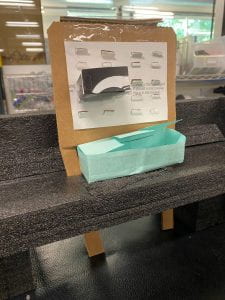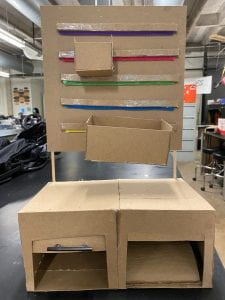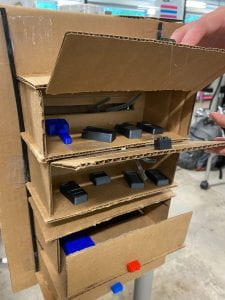This week, we worked on low and medium-fidelity prototypes for three devices that performed well in our screening and scoring matrices: the UFO, the Bucket Builder, and the Ladder. We made a lot of progress, and it’s really cool to see our sketches turn into physical prototypes.
Above is the Bucket Builder, which allows the user to stack containers of various sizes above the UVC sanitizing compartment. The rectangular protrusions that secure the containers were inspired by a similar organizational system in the OEDK.
Here is another rendering of the Bucket Builder. This one uses a horizontal slot system so that the buckets can be secured at any point along the wall. I imagine this would be easier with heavier containers. This prototype also incorporates a sliding door for the storage compartments.
Above is our Ladder prototype. This picture features the 3D-printed handheld devices that Eleanor designed in Fusion. They’re scaled down to a fourth of their actual size, and help to visualize where the devices might be stored in the design. This prototype incorporates wiring for the charging cords in the back, similarly to the medical carts we saw at the BRC this week.
Finally, we made the UFO (Unidentified Fixed Object). This design is stationary, with a modular container that can be removed and carried around the ward. It separates the sanitizing and charging processes into two sections, so that users can choose the function they want. The sanitization compartments are sectioned off so that a device can be removed or added without interrupting the sanitization process of another device.
In addition to prototyping, we presented our project in collaboration with the University of Ibadan in Ibadan, Nigeria. I really enjoyed hearing about the other interns’ projects, particularly the ones related to women’s health. We also conducted another informational interview, where we learned more about user-interface design and saw some back panel wiring in medical carts, which we hope to eventually incorporate into our station.
Next week, we will be consolidating our favorite features from our current prototypes into new designs, which will be created into medium to high-fidelity prototypes with the laser cutter and other tools. I’m looking forward to expanding my skills in circuitry as we install an open circuit into the sanitizing enclosure, which will simulate the UVC light turning off and on automatically.
Until next week!


